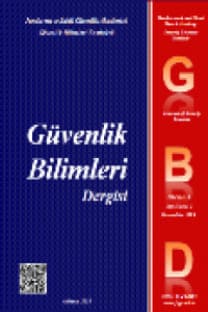TÜRKİYE'DE “ORTA KORİDOR” PROGRAMI İLE “KUŞAK -YOL GİRİŞİMİ” BAĞLANTISININ STRATEJİK ÖNEMİ
Kuşak-Yol Girişimi, Orta Koridor, Türkiye, İpek Yolu, PEST Analizi
THE STRATEGIC IMPORTANCE OF THE “BELT AND ROAD INITIATIVE” CONNECTIVITY WITH THE “MIDDLE CORRIDOR” PROGRAM IN TURKEY
Belt and Road Initiative, Middle Corridor Program, Turkey, Silk Road, PEST Analysis,
___
- AIIB. (18 February 2019). Retrieved from https://www.aiib.org/en/
- Atlı, A. (2016). Turkey’s foreign policy towards China: Analysis and recommendations for improvement. Paper presented at the Policy Paper. Young Academics Program. Istanbul: Global Relations Forum.
- Belt and Road will make Turkey-China cooperation a success. (06 January, 2017). China Daily. Retrieved from http://www.chinadaily.com.cn/opinion/2017- 06/01/content_29580844.htm
- Belt and Road Initiative opens new era of global cooperation Updated: Apr 2017 Xinhua. Retrieved from http://english.gov.cn/news/international_exchanges /2017/04/24/ content_281475635407152.htm. Accessed on May 24, 2018
- Bērziņa-Čerenkova, U. A. (2016). BRI instead of OBOR–China edits the English Name of its most ambitious international project. Latvian Institute of International Affairs, 28.
- Brakman, S., Frankopan, P., Garretsen, H., & Van Marrewijk, C. (2019). The New Silk Roads: an introduction to China’s Belt and Road Initiative. Cambridge Journal of Regions, Economy and Society, 12(1), 3–16. Retrieved from https://doi.org/10.1093/cjres/rsy037
- Business, H.T. (2017). “Modern İpek Yolu Nereye Çıkar?”. Retrieved from http://www.businessht.com.tr/piyasalar/haber/1495794-modern-ipek-yolunereye -cikar
- Chen, Y. (2020). Developments in China–Turkey Relations: A View From China. Critical Sociology, 46(4-5), 777-787.
- China declares 2018 ‘Turkey Tourism Year’. (16 December 2016). Hürriyet Daily News. Retrieved from http://www.hurriyetdailynews.com/china-declares-2018- turkey-tourism-year--107391
- China signs over 130 transport pacts with Belt and Road countries. Retrieved from http://english.gov.cn/news/top_news/2017/04/21/content_281475632838801.ht m. [accessed May 24, 2018]
- Ergin, A. Y. A. N. (2016). Yeni İpek Yolu Stratejileri Ve Trans-Avrasya Güvenlik Sistemleri. Tarih ve Gelecek Dergisi, 2(3), 9-24.
- Ergunsü, U. (2017). İpek Yolu’nun Yeniden Canlandırılması ve Türkiye-Çin Halk Cumhuriyeti İşbirliğine Etkileri. TYB AKADEMİ (Dil Edebiyat ve Sosyal Bilimler).
- Estache, A., Ianchovichina, E., Bacon, R., & Salamon, I. (2013). Infrastructure and Employment Creation in the Middle East and North Africa. The World Bank.
- Fischer, S. (2016). „Turkey and the Energy Transit Question “. Carnegie Europe, 23.
- Güner, B. (2018). Obor Sürecinde Türkiye; Beklentiler Ve Sorunlar. “Turkey In Obor; Expectations And Problems.” Sosyal, Beşeri Ve İdari Bilimler'de Akademik Araştirmalar-Vi, 67.
- Isik, A. F., & Zou, Z. (2019). China-Turkey Security Cooperation Under the Background of the ‘Belt and Road’and the ‘Middle Corridor’Initiatives. Asian Journal of Middle Eastern and Islamic Studies, 13(2), 278-293.
- Ives, D., Hoscheidt, M. M., Jaeger, B., Tocchetto, J. S., & Conference, B. (2013). Infrastructure Investments in the Middle East and North Africa. UFRGS MOdel United Nations Journal, 1, 308-362.
- Jun, Z., Yuan, G., Yong, F., & Hong, Z. (2007). Why Does China Enjoy So Much Better Physical Infrastructure?[J]. Economic Research Journal, 3, 4-19.
- Kadılar, R., & Ergüney, E. (2017). One Belt One Road Initiative: Perks and Chalenges for Turkey. Turkish Policy Quarterly, 16(2), 87.
- Koru, S., & Kaymaz, T. (2016). Turkey: Perspectives on Eurasian Integration. European Council on Foreign Relations (ECFR).
- Kyrgyzstan Suspends Work at New Chinese Refinery. (19 February 2014). Eurasianet. Retrieved from http://www.eurasianet.org/node/68061 .
- Löchel, H., & Nawaz, F. (2018). The Belt and Road initiative of China: A critical analysis of its feasibility (No. 226). Frankfurt School-Working Paper Series.
- Ministry of Foreign Affairs, Republic of Turkey: Turkey’s Multilateral Transportation Policy. Retrieved from http://www.mfa.gov.tr/turkey_smultilateral-transportation-policy.en.mfa
- Özdaşli, E. (2015). Çin'in Yeni İpek Yolu Projesi Ve Küresel Etkileri. Electronic Turkish Studies, 10(14)
- Tang, S. Q., Liu, D. Q., & Xi, X. I. E. (2017). The Analysis of the “One Belt and One Road” for the Game between China and the United States. DEStech Transactions on Social Science, Education and Human Science, (icssm).
- The General Office of the State Council forwarded the Notice of the National Development and Reform Commission, Ministry of Commerce, the People's Bank, the Ministry of Foreign Affairs on further guidance to lead and regulate the direction of foreign investment,”. Retrieved from http://www.gov.cn/zhengce/content/2017-08/18/content_5218665.htm. [accessed May 24, 2018]
- Um, P. N., Straub, S., & Vellutini, C. (2009). Infrastructure and economic growth in the Middle East and North Africa. The World Bank.
- Welcome to the 19th National Congress of the Communist Party of China • Looking back for five years The “Belt and Road” connects the Chinese dream with the world dream. Retrieved from http://news.sina.com.cn/o/2017-10- 26/doc-ifynfrfm9180008.shtml. [accessed May 24, 2018]
- Vodinalı, H. (2018). Bir Türk Koridoru: Kuşak ve Yol. Modern İpek Yolu Dergisi, Sayı.2, s.150-153.
- World's 4th longest tunnel, Ovit opens in Turkey's Black Sea region. (13 June 2018). Daily Sabah. Retrieved from https://www.dailysabah.com/business/2018/06/14/worlds-4th-longest-tunnelovit-opens-in-turkeys-black-sea-region
- Xi J. (2017). The framework of the six economic corridors of the Belt and Road Initiative has been established. Retrieved from http://finance.sina.com.cn/roll/2017-05-14/doc-ifyfeivp5683938.shtml [accessed May 24, 2018]
- Yılmaz, Z., Erdem, C., & Kaya, K. (2019). Yeni İpek Yolu’nun Türkiye Ekonomisine Etkisi. Uluslararası Afro-Avrasya Araştırmaları Dergisi, 5(9), 198-214.
- Zan, T. (2016). “Turkey Dream” and the China-Turkish Cooperation under “One Belt and One Road” Initiative. Journal of Middle Eastern and Islamic Studies (in Asia), 10(3), 50-72.
- Zeybek, H. (2020). Yeni İpek Yolunun kıtalar arası demiryolu konteyner taşımacılığına etkisi: PESTLE analizi. Ömer Halisdemir Üniversitesi İktisadi ve İdari Bilimler Fakültesi Dergisi, 13(4), 724-740.
- ISSN: 2147-2912
- Yayın Aralığı: 2
- Başlangıç: 2012
- Yayıncı: JANDARMA VE SAHİL GÜVENLİK AKADEMİSİ
ÖLDÜRME SUÇUNUN SOSYOLOJİK SEBEPLERİ
TÜRKİYE'DEKİ TRAFİK KAZALARININ PERİYODİK YAPISININ ARAŞTIRILMASI
Yılmaz AKDİ, Yunus Emre KARAMANOĞLU, Kamil Demirberk ÜNLÜ, Cem BAŞ
ASAYİŞ HİZMETLERİNDE TEKNOLOJİ KABUL MODELİ: GEÇERLİK VE GÜVENİRLİK ÇALIŞMASI
Güray ARIK, Süleyman Sadi SEFEROĞLU
2001 SONRASI NATO’NUN TERÖRİZMLE MÜCADELE UNSUR, ARAÇ VE POLİTİKALARININ KÜRESEL GÜVENLİĞE ETKİSİ
İNSANSIZ HAVA ARAÇLARININ ADLİ BİLİŞİM AÇISINDAN İNCELENMESİ
TÜRKİYE'DE “ORTA KORİDOR” PROGRAMI İLE “KUŞAK -YOL GİRİŞİMİ” BAĞLANTISININ STRATEJİK ÖNEMİ
Özlem Arzu AZER, Yasemin ULKER, Wei MİN
DENİZ YOLUYLA UYUŞTURUCU KAÇAKÇILIĞINDA KULLANILAN NARKO-DENİZALTILAR ÜZERİNE BİR İNCELEME
Murat Erdem AYHAN, Umut SÖNMEZ
DİLENDİRİLEN ÇOCUKLARIN GÖRÜNMEZLİĞİ
